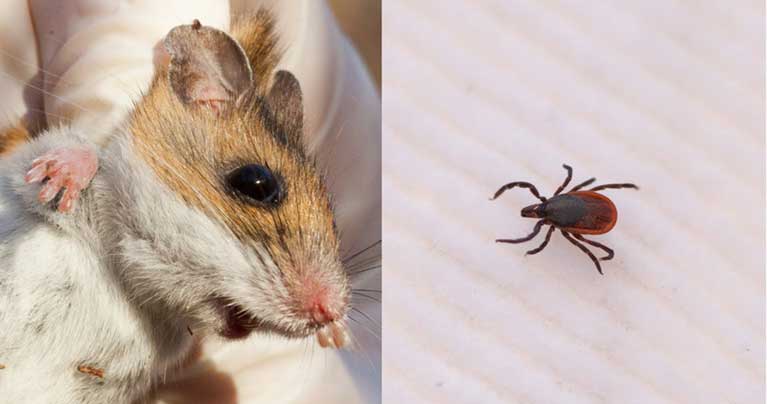Scientists predict a rapid increase in the number of Lyme disease patients in 2017. They attribute this prognosis to the extreme increase in the number of mice from the last summer. And the Northeastern United States are a particular hot spot for the little rodents.
Last summer Felicia Keesing was unpleasantly surprised when she returned from a trip and discovered a significant presence of various rodents in her home in New York.
"There were mice leftovers everywhere. They have completely invaded us," says Keesing, an ecologist currently at Bard College.
"We have also found corpses of dead mice on our kitchen floor," says Rick Ostfeld, also an ecologist and Keesing's husbandThe Hudson River Valley was plagued with mice during the last summer. The critters were all over the place. And while most people were bummed out by this, for the wary couple, the plague meant something much more disturbing.
"We are anticipating this year to be a quite risky one for Lyme disease," says Ostfeld.Rick Ostfeld and his wife Felicia are have been searching for ways to stop Lyme disease for more than 20 years. And they have invented a reliable way to prognosticate the impact of Lyme disease, one season in advance. Their system ties the number of mice discovered from the previous year, mainly the summer, to the potential of new cases of Lyme disease in the next year.
What is Lyme Disease?
Lyme disease is an infection causes primarily by infected ticks which spread dangerous bacteria. In the United States, these ticks are of the type known as deer ticks and black-legged ticks. Lyme disease symptoms include severe headaches, fever, loss of movement in the left or right sides of the face, neck pain, and cardiovascular problems. Its name comes from a city in Connecticut which carries the same name and has the first registered patient back in 1975.Where do mice come along in the story?
The biggest spreaders of ticks are mice. Other animals tend to groom away and kill ticks. But mice are one of the rare animals that have no problem with tolerating ticks in their fur and their face. The ticks that we mentioned above get the dangerous bacteria that causes Lyme disease from the mice blood they leech. And so they spread them around everywhere they go. Eventually, this widespread mice epidemy can cause a Lyme disease outbreak. It mainly depends on the rate of which the mice are reproducing in a given mating season.How can we protect ourselves against the disease?
The most common way to contract the disease is by walking in the woods or the park without protecting yourself first. One way to protect your skin is to use insect repellant. Check your body for possible ticks after you return to your home from the outdoors. Immediate removal of the ticks can prevent Lyme disease.“One single mouse can carry up to 50, 60, even 100 ticks that cover his ears and face,” says Outfield.And because up to 95 percent of the ticks are infected with the Lyme-causing bacteria, if left untreated, it could have a devastating effect on the population. The mice rate was highest in Northeast U.S, but Lyme disease can appear anywhere in the U.S. Specifically, anywhere in the Northern hemisphere of the world due to the appropriate temperate regions. Kiersten Kugeler, of the Centers for Disease Control and Prevention (CDCP), urges that:
"... It is important that we inform people about the spreading of Lyme disease to new areas".
The escalation and treatment of Lyme Disease
A CDC report from 2015 warned that Lyme disease has spread to 260 counties in the U.S. Particularly the East Coast and has even begun to move into the Midwest. If you want to evaluate the risk level to your location, we have this interactive map that shows the incidents of dog-related diseases in your area, as recommended by LymeDisease.org. This method is a good indicator considering the fact that dogs get screened more routinely for Lyme disease, as opposed to humans. We can treat Lyme disease with antibiotics. It usually takes a couple of weeks for efficient removal of the bacteria from our system. If you sense and treat the disease in its early stages, it will lead to a faster recovery time. On the other hand, if we leave the disease untreated, the infection could attack our nervous system, the joints, and even the cardiovascular system. On rare occasions, patients suffering from the disease will continue to experience its symptoms even after the usual treatment time passes. In these cases, antibiotics can not help as effectively because, as experts believe, the organism develops an autoimmune response to the disease. Just remember to watch out for any ticks when you walk in the parks and forests this spring. Make sure to prepare well in advance. Spring and early summer are periods when the Lyme disease is spreading in its full effect. Carry an insect repellent with you and protect your visible skin. Don't forget to spread the awareness of the danger of Lyme disease outbreak by sharing this news article on social media. Maybe some of your and family will find it helpful and will decide to exercise caution this spring. Source: SympleMost, National Public Radio Image source: National Public Radio
Leave a Comment

